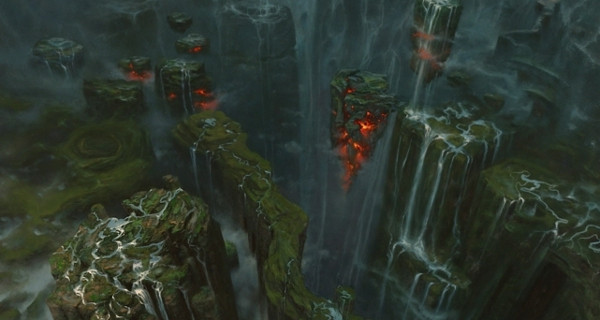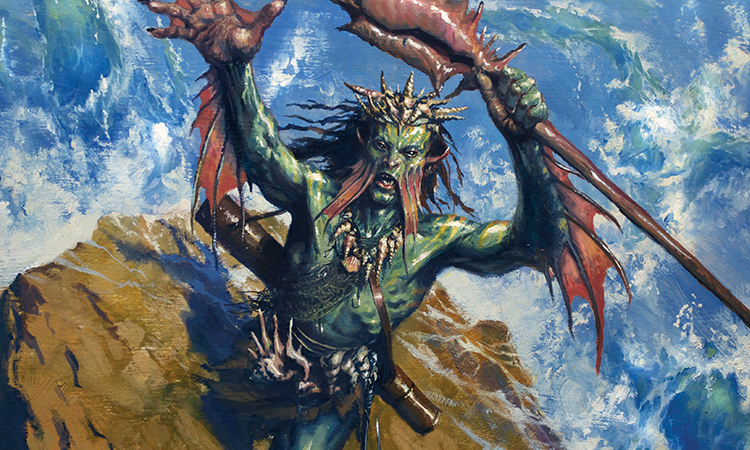I was hoping this could be my "Z is for Zendikar" post for the "To Boldly Go" Blog Carnival hosted by my friend Gonzalo, and in a way it will be, but again this will be more brainstorming then finished material, as usual.
This time though, I feel particularly inspired, and I think I have nailed my vision of the backgrounds of Zendikar and at the same time a fix to one of the issues I have with most editions of D&D: non-combat features mattering only as first level choices.
In my last post I noticed how the fact that Zendikar poses new challenges and mechanics by itself can be used to give Races something extra, without it really unbalancing things, since it will be consequential only within Zendikar and only within the influence of the Roil.
This made me think that we can apply this lesson to Backgrounds, but then I thought: what about the regular backgrounds from the Player's Handbook? You can add only so much Zendikari flavor to them, before making them all feel similar.
This made me think about Backgrounds more radically: many features I would like Backgrounds to give are the domain of Classes now, and I don't want Zendikar to just feel like "over the top D&D", offering just more without taking anything away.
So the main solution I have in mind is to actually nerf Backgrounds at first level, and then make them reach the usual features around 3rd level, with additional features kicking in at higher levels, when the power level of the character should eclipse buffs in the Background domain.
Plus, taking a hint from the "Custom Background" rules, they would actually offer choices, acting more like "curricula" than backgrounds. After all, there's already basically free choice when the skills of Background and Class overlap.
Basically, there should be a progression table, or "menu" for Backgrounds. Let's take one of the free ones:
Criminal.
Level Feature
- Feature: Criminal Contact, Thieves' Tools, One skill
- Criminal Specialty, One tool
- One skill
- Feature: Specialty Mastery
- Expertise in one skill
The skills could come from the whole Rogue list, with tools being much more limited
So the real power up here is an Expertise. How big is it? Well, it's basically like half a feat. At 4th level, potentially, Humans can get it through the Prodigy feat, so a Human Rogue could end up with a lot of Expertise. The use of a "Skill Die" could make everything more fun, so it could be considered even instead of proficiency, but this could add more complexity.
In general I think gaining an extra Expertise would not hurt at all, but I could see about making it situational.
What requires work is basically a second feature, making the Specialty matter more. This could actually mean choosing between 8 different mini-features (a lot of writing to do for just one background!) or possibly a free-form feature, where the DM just figures out the details with the player. A compromise could be a fixed feature, representing the mastery of the background in general, leaving the specialty as it is now: a role-playing cue without any noticeable in-game effect.
Other options I was considering:
- Removing Thieves' Cant from the Rogue features, making it a Criminal Background feature, thus removing this BUG, where all Rogues are Thieves in the book.
- Adding even some combat-related bonuses to the Background, as substituion features. The power level should be something akin to a 1st level spell slot. As a Rogue, for example, I think Expertise would count as 1 slot, and Sneak Attack as another slot. So basically gaining Sneak Attack could be a replacement of a 1st level slot, or Expertise (but it would not stack with the Rogue feature, so basically the Rogue would never take it), or Fighting Style from Fighter/Ranger/Paladin, etc.
The problem is this feature=feature equivalence is broken: a Paladin would easily give away Divine Sense to gain Sneak Attack, while it's much more balanced with Lay on Hands. So a blacklist of un-swappable should be made, where Thieves' Cant, Divine Sense, Druidic language and such "flavor on top" features are taken out of the menu.
- The above "flavor on top" features are actually the ones I would remove from classes in general, and it could be a prerequisite of using these powered-up backgrounds: some classes lose something, which they can easily regain with the right Background.
Going this way, here is another rework of the
Criminal Background:
Level Feature
- Thieves' Cant, Thieves' Tools, One skill - Feature swap: Sneak Attack
- Criminal Contact, One tool
- One skill - Feature swap: Sneak Attack
- Feature: Specialty Mastery
- Expertise in one skill
No Rogue would get Thieves' Cant without the Criminal Background. But no Rogue would use it to gain more Sneak Attack (since the feature is offered at the same levels they get it in). So you can either become a classical Thief Rogue, or if you select this as a Wizard, you can potentially be as good at Sneak Attacks as a 3rd level Rogue, if you let go of two 1st level Spell Slots.
At 5th level, a Criminal Wizard having swapped twice, would have only 2 first level spell slots, but would also have one Expertise and 2d6 Sneak Attack.
Conversely, the Sage background would act as a multiclass Wizard of sorts:
Level Feature
- Obscure Language, One skill - Feature swap: Spell Slot, Spell Known
- Researcher, One language
- One skill - Feature swap: Spell Slot, Spell Known
- Feature: Specialty Mastery, One language
- Expertise in one skill
The Soldier, not giving out a flavor class feature for free (because no martial class has one, unfortunately), would need a bit of a different progression, granting the feature before. To compensate, the Military Rank would be up-gradable.
Level Feature
- Military Rank, One skill - Feature swap: Fighting Style
- One skill, One tool
- Military Rank up - Feature swap: Maneuver, Superiority Die
- Feature: Specialty Mastery, One vehicle
- Expertise in one skill
And so on.
So what would an actual Zendikari background look like? A Lull Mage Apprentice could be represented.
Level Feature
- Academy Contact, One skill - Feature swap: Spell Slot, Spell Known
- Minor Lull Magic, One tool
- One skill - Feature swap: Spell Slot, Spell Known
- Feature: Specialty Mastery, One language
- Expertise in one skill
Minor Lull Magic could give a daily version of the Lull Mage feat, usable only once per day, unless you burn Spell Slots, which the Background conveniently provides. This would combine well with the feat, giving basically more uses, without providing any extras (the feat should raise Wisdom or Intelligence by 1).
Academy Contact sounds more like the regular Background features which I moved to second level in other cases, but in reality it's more like the Thieves' Cant: something situational, which comes up only with your own, since the Academy/ies in Zendikar don't have the widespread networks of criminals, or the more widely recognized ranks of military.
And now the most Zendikari of Zendikari backgrounds: Explorer!
Level Feature
- Expeditionary House, One skill - Feature swap: Natural Explorer
- Treasure, One tool
- One skill - Feature swap: Natural Explorer (2nd terrain)
- Feature: Specialty Mastery, One language
- Expertise in one skill
Again as per the Lull mage, we have the "social" feature, more limited than most, at first level, while the true feature would be something akin to the Hermit "Discovery", but represented by a material object: a unique hedron cube, or some arcane device of this kind, able to provide some out-of-combat help in the same way the feature of the Hermit would, but on a less "cosmic truth" level and a more practical, yet limited fashion.
Note that offering Natural Explorer at a faster rate than Ranger means that a Ranger Explorer would be more Explorer than a regular Ranger, if swapping one spell slot. For a Rogue it would mean swapping one Sneak Attack to be "as explorer" as a Ranger of the same level, or they could choose to be "even more explorers" than a Ranger of the same level by taking out all Sneak Attack till 3rd level included. Choices!
I realize these could feel more like Multiclass rules rather than Background rules, but again, the fact they provide class features in lieu of others of the same kind I think balances things a lot, just with the actual extra stuff being just a secondary background benefit and expertise in a single skill, coming at levels that usually don't make these bonuses very consequential, and more as "nice to haves".
Another possible way to make "beefy backgrounds" more applicable to any game, would be making them actual class levels, making you choose if to level up in background or class.
This would make them basically prestige classes of sorts, and slow down a lot the progression, making them contrary to my game design philosophy tenet of "combat and non-combat features not having to compete with each other".
Considering this, I think a good optional rule to balance things out could be requiring specific quests to actually attain 4th and 5th level in a background: those features would basically be the rewards in treasure and XP of the quest, and would be instead of these.
That'all!

















